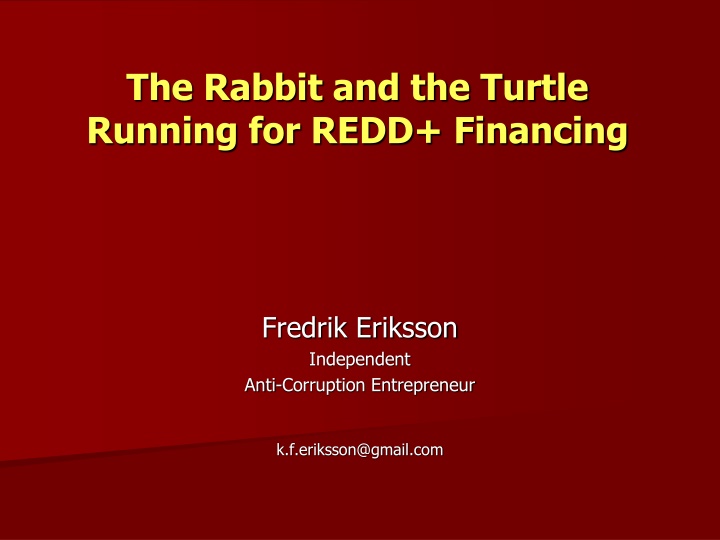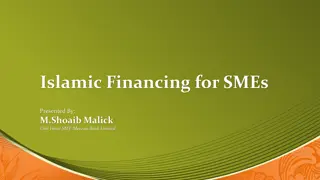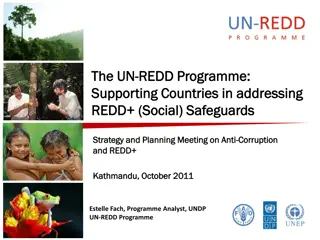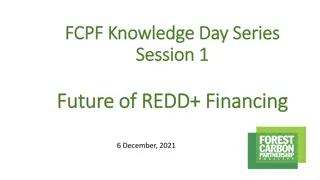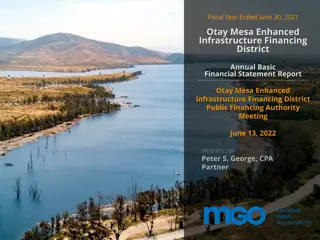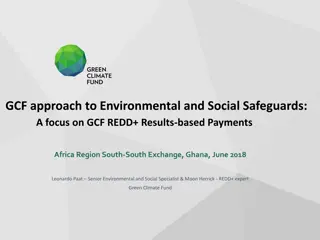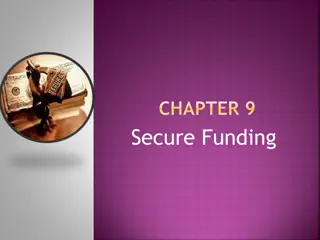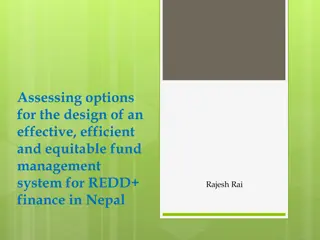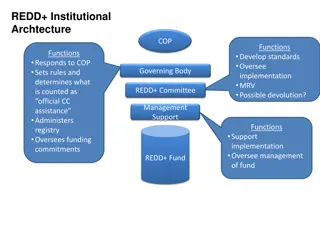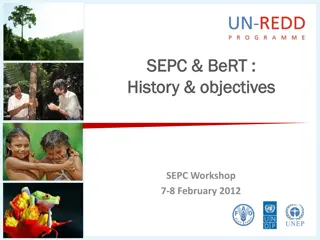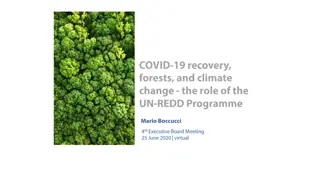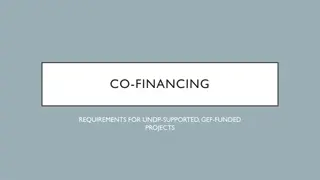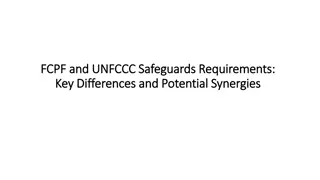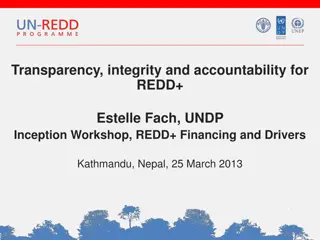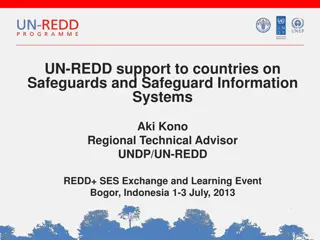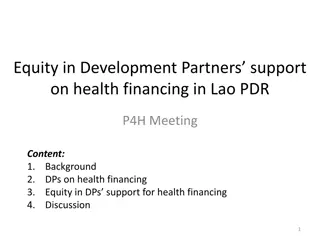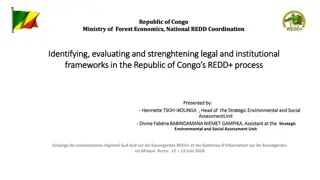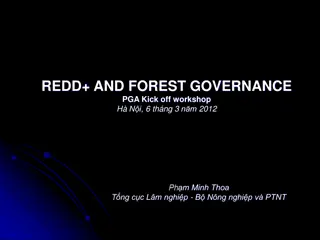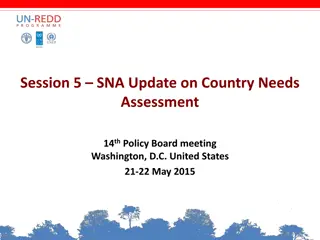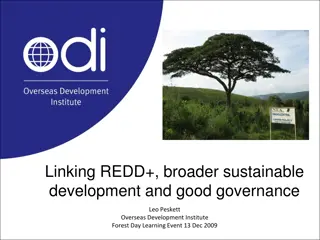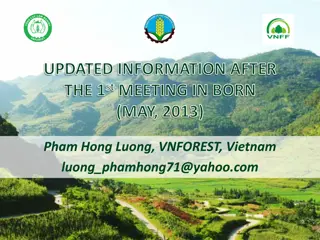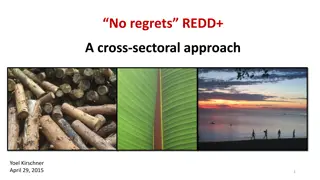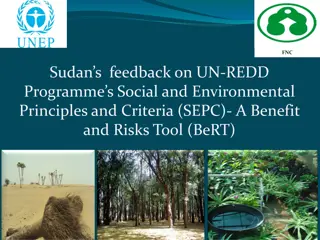REDD+ Financing: Meeting Standards and Funding Needs
Explore the world of REDD+ financing, from accessing funds to meeting standards and securing necessary capital. Learn about the estimated extent of capital needed and projected financing needs in the quest to reduce emissions from the forest sector. Discover the role of private finance and multilateral funding in supporting REDD+ projects.
Download Presentation

Please find below an Image/Link to download the presentation.
The content on the website is provided AS IS for your information and personal use only. It may not be sold, licensed, or shared on other websites without obtaining consent from the author.If you encounter any issues during the download, it is possible that the publisher has removed the file from their server.
You are allowed to download the files provided on this website for personal or commercial use, subject to the condition that they are used lawfully. All files are the property of their respective owners.
The content on the website is provided AS IS for your information and personal use only. It may not be sold, licensed, or shared on other websites without obtaining consent from the author.
E N D
Presentation Transcript
The Rabbit and the Turtle Running for REDD+ Financing Fredrik Eriksson Independent Anti-Corruption Entrepreneur k.f.eriksson@gmail.com
Project Financing Start up costs: private finance, multilateral, bilateral or NGO funding. Emission reduction credits (verified carbon reduction meeting certain standards) can later be sold on the voluntary carbon market where companies can buy credits to offset their own emissions. This provides further finance/profit to carbon reduction projects.
Standards to meet for accessing REDD+ funds (Source: TI, A Manual for Assessing Integrity in the Development and Implementation of Forest Carbon Projects and National REDD+ Strategies (Berlin: Transparency International, 2011), p. 24.)
Standards to meet for accessing REDD+ funds Massive funding gap to meet the needed scale of emmission reductions appears to hinge on the certainty of a compliance market (access to large scale capital depends on reliable risk calculations for returns) If standards too stringent and subsequently lower the prospects for approved carbon credits, access to capital will be more difficult are PPPs a response to that risk? What does that say about the need for independent verification?
The Estimated Extent of Capital Needed EliaschReview: halving emissions from the forest sector by 2030 could total US$17 33 billion per year. IWG: US$ 20 billion needed by 2015 to cut deforestation by 25%, plus US$ 4 billion for reduction of emissions from forest degradation. Current funding is approximately US$ 1.5 billion per year during the fast start period.
Projected Financing Needs (Source: Forum for the Future (2009), Forest Investment Review)
Sources Bilateral & multilateral financing makes up 90% of the funding to date, and focuses mainly on readiness activities Current pledges might be enough to support Phase 1 Private finance is crucial for Phase 2 & 3 the funding gap (Source: Gledhill, R.; Towards Building a Governance Framework for REDD+ Financing , presentation Sept 2011, Panama)
Financial Flows (Source: PwC (2010), National REDD+ funding frameworks and achieving REDD+ readiness - findings from consultation, Report for the Conservation Finance Alliance)
Standards and Mechanism Still Missing or Emerging for REDD+ Financing Standards for Accessing Funds in Various Financing Mechanisms safeguards - Best fit rather than blanket best practice (risk: too much slack due to conflicts of interest) -Risk mitigation required to politically defend legitimacy of aid -Each financing mechanism has its own Mgt structures -Need to represent trade-offs between the need for large scale private sector funding; the lack of time and various Coordination Mechanism for Various Funding Mechanism -Accessible project database -Transparency standards for funded projects -Private and public funds Standards for Assessing and Verifying Financial Governance Standards -Monitoring mechanism: focus on risk prevention for various types of leakages in relation to intended beneficiaries (conflicts of interest and transparency standards to avoid capture) -Auditing (risk: as with MRV, conflicts of interest make audits weak) -National level/project level Standards for Financial Reporting Accountability Standards and Mechanisms when Standards are Breached -More sophisticated than current zero-tolerance -policies -Allows donors to embrace risk but satisfy responsible management of risks. -Accountability for private sector? Denied credits; criminal offences (legal/physical persons); accounting regulations; beneficial ownership must be assured (FATF 40+9); jurisdiction in other countries (OECD Convention?).
Time for Change and Trade-offs What do we know of how long governance change takes to achieve at national level? Can we wait for standards to be met while the attractiveness of the alternative development route fades away as a political option? In weak governance contexts with strong regimes (elites), change can be effectuated by those who wield power. How do we relate to various types of governance regimes, where the instrument of law have very different effectiveness and the informal institutions cannot be separated from the formal? In personalistic governance regimes, rent-creation or corruption is not simply a method of lining the pockets of the dominant coalition of elites it is the essential means of controlling violence (North, Wallis and Weingast, 2009, p. 113) Is national ownership and leadership the right approach in all contexts for all governance aspects where the political-economic conditions for change are bleak? Is there anything to learn from pre-modern tools of governance and custodianship? Do we have sufficiently urgent arguments for that yet?
Time for Change and Trade-offs Sovereignty is a concept which arrived at the birth of modernity in the 16thCentury. It can be seen as Janus-faced in that it turns both inward at the population as supreme authority, but also outward at other countries as independent although never supreme. (Jackson, R.; Sovereignty (Cambridge: Polity, 2007), p. 11.) In an increasingly globalized world, where chains of actions transgress sovereign nations, but government the action or manner of governing- still only exists at national level, the situation could be referred to as an international governance deficit. What does the emergence of a post-modern and perhaps post-sovereign world mean a global economy, a transnational civil society, a transnational underworld that escape from the authority and the regulation we associate with the sovereign state, as well as the states system of sovereign states. (Jackson, R.; Sovereignty (Cambridge: Polity, 2007), p. 141.) The principle of state sovereignty has taken international public interests hostage, such as addressing global climate change issues. No effective global governance system exist to govern international public interests, but all depends on the political will of sovereign states. But when that will is missing and moral persuasion is futile? Is all written in stone? No choice?
Do we need to change the route of the race, find a new vehicle or change the finish line, or risk...
